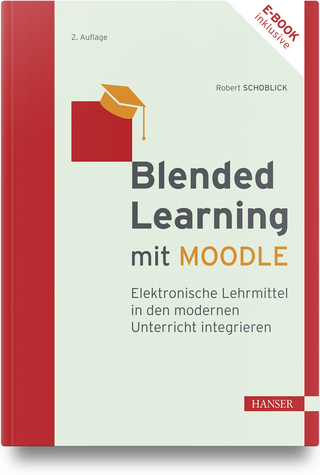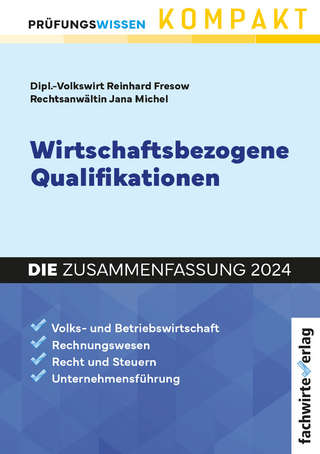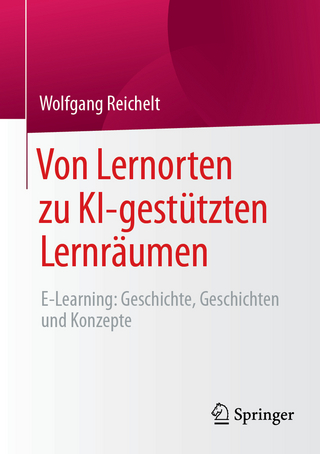
Transforming Education with Virtual Reality
Wiley-Scrivener (Verlag)
978-1-394-19999-0 (ISBN)
Virtual reality (VR) technology has thoroughly transformed education by providing engaging and immersive ways for students to experience their education and by offering visual learning, creative development, etc., to enhance their studies. Moreover, with increasing accessibility, both students and educators can utilize it for effective teaching and learning. By embracing this VR-related technology, teachers can transform traditional classrooms into lively ones. Businesses can also leverage VR for skilling, up-skilling, and re-skilling.
This book is divided into two parts. Part I discusses the opportunities, challenges, and application of VR technology, and Part II focuses on reimagining education with the metaverse.
Readers will find in this book:
a description of the relationship between virtual reality and student behavior;
a review of VR-enabled tools and techniques for an immersive environment;
a discussion on VR in the context of vocational education by developing a conceptual framework and roadmap for its adoption;
an overview of the advantages, disadvantages, and mechanisms of VR through a detailed analysis showing a comparison of the strong and weak points of the technologies being used in education;
a look at the future of learning in the context of VR;
a description of the relevance of VR in emerging economies with the help of bibliometric analysis and discusses its future potential;
a review of Metaverse as a new education avatar showcasing diverse educational experiences and how to reimagine teaching;
an explanation of the relevance of emerging digital technologies in upskilling employees in fashion retail to impart an immersive experience for customers;
a proposed framework for mapping the use of VR for students with autistic spectrum disorder (ASD).
Audience
The book is designed for information technologists, educational researchers, teachers, policymakers, government officials, and business managers.
Reena Malik is an assistant professor at the Chitkara Business School at Shitkara University in Punjab, India. She has a PhD in marketing management and a degree in commerce and management. She has published three books, various research papers, and book chapters. She has been teaching for the last ten years and actively works in research areas like consumer behavior, brand management, and customer satisfaction. Ambus Sharma is an assistant professor at Ballabh Pant Social Science Institute, Allahabad, India. He received his PhD in management and business administration sciences from Szent Istvan University, Hungary. His research areas include diversity management, human resources practices, and disability studies. He has published multiple research articles in international journals. Prashant Chaudhary is an associate professor with Dr. Vishwanath Karad at the MIT World Peace University, Pune as well as an associate professor at the School of Management. He has authored two books and won various awards including the Innovative Educator Award.
Preface xvii
Part 1: Modern Technology in Education: Opportunities, Application and Challenges 1
1 A Novel Adaptive Framework for Immersive Learning Using VR in Education 3
Sudharson D., Reena Malik, Rithish Ramamoorthy Sathya, Vaishali V., Balavedhaa S. and Gautham S.
1.1 Introduction 4
1.2 The Two Perceptive Elements 6
1.3 Immersive Tools and Technologies 9
1.4 The Methodology 13
1.5 Interaction Through Voice Assistant 16
1.6 Improved Distraction Tracking 16
1.7 Discussions 19
1.8 Market Analysis 20
1.9 Result 24
1.10 Conclusion 24
2 When Technology Meets Tradition: Rediscovering Tribes Through Virtual Reality 27
Debanjana Nag
2.1 Introduction 28
2.2 Concept of Communication and Virtual Reality as a Tool of Communication 29
2.3 The Tribes and the Concept of ‘Modern’ Society 32
2.4 Status of Women in Tribal Societies 33
2.5 Socio-Political Systems of Tribal Societies 34
2.6 Conditions of Education, Health and Hygiene 34
2.7 Application of Virtual Reality as a Learning Pedagogy to Understand Tribal Aspects 36
2.8 Problems in the Implementation of VR Among the Tribes 38
2.9 Utilization of Virtual Reality to Connect Tribes with the Mainstream 40
2.10 Epilogue 42
3 Post-Pandemic Approaches Through Various Advanced Toolkits for Online Teaching and Learning Confidence 47
Karthikeyan Kandasamy, Prakash Maran Jeganathan and Shalini Surajmani
3.1 Introduction 48
3.2 The Impact of Technology on Learning 49
3.3 MAXHUB UC BM35 Bluetooth Teleconference Speakerphone 53
3.4 4K Ultra HD 55
3.5 BenQ EdTech 57
3.6 Conclusion 58
4 Expanding Teaching Possibilities: Applications of Technological Products in Education 61
Jyoti Verma and Gagandeep
4.1 Introduction 61
4.2 Benefits of Technology in the Education Sector 64
4.3 Applications of Technological Products in Education 65
4.4 PESTLE Analysis of Technological Products in the Education Sector 67
4.5 Successive Growth of Technological Products in India 68
4.6 Conclusion 69
5 Evolutionary Advantages of Virtual Reality in Education 73
Richa Kapoor Mehra
5.1 Introduction 73
5.2 Differences Between Real and Virtual Space 76
5.3 Use of Virtual Reality: A Matter of Concern 82
5.4 Conclusion 84
6 Exploring Possibilities and Apprehensions About Application of Artificial Intelligence in Higher Education 87
Siddharth Shimpi
6.1 Introduction 88
6.2 The Current State of AI in Higher Education 90
6.3 Advantages of AI in Higher Education 91
6.4 Potential Risks of AI in Higher Education 91
6.5 Ethical Considerations in AI in Higher Education 93
6.6 Future of AI in Higher Education 94
6.7 Case Studies 95
6.8 Best Practices 96
6.9 Conclusion 96
7 Impact of Virtual Reality on Immersive Education 101
Manju Rani
7.1 Introduction 102
7.2 Techniques Used in Immersive Learning 103
7.3 Advantages of Immersive Learning 104
7.4 Disadvantages of Immersive Learning 105
7.5 Virtual Reality 105
7.6 Processing of VR 107
7.7 Types of Virtual Reality 108
7.8 Developing Content for VR 109
7.9 Creating a Virtual Reality Environment 109
7.10 VR in Education 112
7.11 E-Learning and VR 113
7.12 The Usefulness of VR Technology in the Field of Education 114
7.13 VR in Teacher Training and Pedagogy 118
7.14 Creating an Immersive VR Environment with MaxWhere 118
7.15 Applications or Software for Using VR Technology in the Field of Education 120
7.16 Growth of VR Technology in Education 121
7.17 Obstacles in Using VR Technology 122
7.18 Interpretation of Results 122
Part 2: Reimaging Education with Metaverse 127
8 The Metaverse in Education: An Upcoming Future Trend 129
Priya Jindal and Ansh Jindal
8.1 Introduction 130
8.2 XR in Metaverse 130
8.3 Categories of Extended Reality (XR) 131
8.4 XR and Learning 133
8.5 Approaches of Learning in Metaverse 135
8.6 Comparison of Classes in Person, Virtual Classes, and in the Metaverse 137
8.7 Challenges of Metaverse in Education 138
8.8 Trends Supporting Metaverse in Education 140
8.9 Conclusion 141
9 Role of Virtual Reality in Education: Its Scope, Reach and Effect on Student Behavior 145
Shweta Kapoor and Gitanjali Kalia
9.1 Introduction 146
9.2 Types of Virtual Reality 148
9.3 Various Types of Augmented Reality 149
9.4 Virtual and Augmented Reality 150
9.5 Application of Virtual Reality 151
9.6 Implementation of VR in Education Sector 155
9.7 Effects of Virtual Reality on Student Behavior 157
9.8 Positive Effect of Virtual Reality on Students 158
9.9 Negative Effect of Virtual Reality on Students 159
9.10 Challenges Faced when Implementing VR in Education Sector 160
9.11 Conclusion 161
9.12 Forming New Perspectives 162
10 Virtual Reality in Education: Benefits, Applications and Challenges 165
Rajni Bala and Prachi Gupta
10.1 Introduction 166
10.2 Industry Key Players in VR in Education 167
10.3 VR Market Segmentation in the Education Sector 168
10.4 Application of VR in Education 168
10.5 Distance Learning 170
10.6 Advantages of VR in the Classroom 170
10.7 Disadvantages of VR in the Classroom 172
10.8 How VR Will Improve Education 173
10.9 Challenges of Implementing VR in Education 174
10.10 How to Maximize the Benefits of VR in Education 176
11 Exploring the Landscape of Virtual Reality in Education: A Bibliometric and Thematic Analysis 181
Natashaa Kaul and Chanakya Kumar
11.1 Introduction 182
11.2 Literature Review 183
11.3 Methodology 185
11.4 Findings and Results 187
11.5 Methodology and Research Perspectives 188
11.6 Temporal Analysis Using Word Clouds 189
11.7 Future Research 192
11.8 Conclusion 193
11.9 Implications for Research and Practice 196
11.10 Limitations of the Study 197
12 VR in Vocational Educational and Training: Conceptual Framework and Adoption Roadmap 201
Kumar Shalender, Babita Singla and Sandhir Sharma
12.1 Introduction 201
12.2 Benefits of VR in Training 203
12.3 VR Adoption Framework 206
12.4 Conclusion and Discussion 207
13 Virtual Reality in Education — A Blessing or Curse? 211
Priya Jindal, Ansh Jindal and Radhika Gambhir
13.1 Introduction 212
13.2 Virtual Reality 212
13.3 VR in Education 214
13.4 Conclusion 224
14 Virtual Reality: A Mechanism for Modern Education 229
Deepali Bhatnagar and Adity Boruah
14.1 Introduction 230
14.2 What Makes Learning Deep Rooted? 231
14.3 Definition of Virtual Reality 232
14.4 Virtual Reality as an Instructive Tool 234
14.5 Educator and Student Acceptance of VR Use in Education 236
14.6 Statistics of the Usage of Virtual Reality in the Education Sector 237
14.7 Enablers for Teaching with Technology 239
14.8 Virtual Reality in Modern Education: Benefits 240
14.9 Areas of VR Application in Education 241
14.10 Constraints and Challenges in the Path of VR Learning 242
14.11 The Road Ahead 242
14.12 Conclusion 244
15 Application of VR Technology in the Educational Sector — Opportunities and Challenges 249
Sushmitha Abhishek Rao, Bonnie Rajesh and Rajesh Raut
15.1 An Introduction to Virtual Reality 250
15.2 Literature Review 250
15.3 Important Elements of Virtual Reality (VR) 251
15.4 Features of VR 252
15.5 Opportunities of Virtual Reality in Education 253
15.6 Challenges of Virtual Reality in Education 257
15.7 Conclusion 259
16 Is Virtual Reality Really the Future of Learning? 263
Rajneesh Ahlawat, Renu Tanwar and Preeti Ahlawat
16.1 Introduction 264
16.2 Virtual Reality History 264
16.3 Virtual Reality Learning 265
16.4 Benefits of Using Virtual Reality in Education 265
16.5 Disadvantages of Learning through Virtual Reality 267
16.6 Virtual Reality Applications 268
16.7 Types of Virtual Reality 270
16.8 Virtual Reality: Statistics 271
16.9 Education with Virtual Reality 271
16.10 Virtual Reality Used in Schools 272
16.11 Virtual Reality’s Impact on Modern Education 272
16.12 Virtual Reality Examples 273
16.13 Classroom VR Implementation 275
16.14 Secondary Schooling Using VR 276
16.15 VR for Students who Struggle with Studying 277
16.16 Difficulties in VR Education 277
16.17 Future of VR in Education 279
16.18 Conclusion 279
17 Application of Virtual Reality for Education 283
Ramkrishna Dikkatwar, Nilesh Kate, Saradhi Kumar Gonela and Prashant Chaudhary
17.1 Introduction and Background of the Study 284
17.2 Literature Review 284
17.3 Methodology 286
17.4 Literature Section 287
17.5 Bibliometric Analysis and Discussion 290
17.6 Conclusion and Future Scope 302
18 Metaverse: A New Avatar-Based Technology for Diverse Educational Experiences 311
Pooja Darda, Shailesh Pandey, Om Jee Gupta, Susheel Yadav and Reena Malik
18.1 Introduction 312
18.2 Literature Review 313
18.3 Research Methodology 315
18.4 Proposed Framework for Metaverse Applications in Education 315
18.5 Limitations 317
18.6 Future Scope 317
18.7 Implications 318
18.8 Conclusion 318
19 Up-Skilling in Fashion Retail 323
Prashant Chaudhary, Neelam Raut, Harshali Patil and Nilesh Kate
19.1 Introduction 324
19.2 Literature Review 326
19.3 Findings and Conclusion 329
19.4 Practical Implications and Discussion 330
19.5 Scope for Future Studies 332
20 Metaverse: Reimagining the Future of Teaching-Learning 337
Mihir Vaidya and Meenal Pendse
20.1 Introduction 338
20.2 Using Metaverse and Its Tools in Education 338
20.3 Advantages, Disadvantages, Challenges and Remedies to Challenges 342
20.4 Organizations Working on Integrating Technology with Education 347
20.5 Conclusion 349
21 Proposed Framework to Map Virtual Reality with Ancient Indian Education System to Increase Neuroplasticity for Autistic Spectrum Disorder Children 351
Noor-A-Nabi Khan, Naheeda Tharannum B., Khondekar Lutful Hassan and Habiba Hussain
21.1 Introduction to Autism Spectrum Disorder 352
21.2 Studies on Autism Spectrum Disorder 354
21.3 Studies on Virtual Reality 355
21.4 Studies on Ancient Indian Education System 356
21.5 Studies on Neuroplasticity 357
21.6 Brain: Normal and Autistic Children 357
21.7 Research Area Explored and Unexplored 359
21.8 Proposed Problem Statement 359
21.9 Aim and Objectives 360
21.10 Ancient Indian Education System: Holistic Development 360
21.11 Holistic Development: From Autism to Being Normal 361
21.12 Virtual Reality and Autism Spectrum Disorder 362
21.13 Implementation of Virtual Reality: Education 365
21.14 Mapping Virtual Reality and Ancient Indian Education System 366
21.15 How Virtual Reality Helps Autism 366
21.16 Algorithm for Virtual Reality in Autism 367
21.17 Pseudocode for Virtual Reality in Autism 368
21.18 Proposed Neuroplasticity-Enabled VR Ancient Indian Education 369
21.19 Implementation of Neuroplasticity in VR 370
21.20 Computer Programming on VR with Ancient Indian Education 372
21.21 Computer Programming on Neuroplasticity Development 373
21.22 Conclusions 374
21.23 Future Scope 374
22 Virtual Reality in Education: Analyzing the Literature and Bibliometric State of Knowledge 379
Manpreet Arora
22.1 Introduction 380
22.2 Research Questions 382
22.3 Methodology 382
22.4 State of Knowledge Published on the Term "Virtual Reality in Education" in SCOPUS Database 382
22.5 Main Research Themes Covered in the Top Articles 397
22.6 What Literature (available in SCOPUS) States about the Concept of VR in Education 399
22.7 Conclusion 399
References 400
Index 403
| Erscheinungsdatum | 14.02.2024 |
|---|---|
| Sprache | englisch |
| Gewicht | 903 g |
| Themenwelt | Schulbuch / Wörterbuch ► Unterrichtsvorbereitung ► Unterrichts-Handreichungen |
| Mathematik / Informatik ► Informatik | |
| Sozialwissenschaften ► Pädagogik | |
| ISBN-10 | 1-394-19999-6 / 1394199996 |
| ISBN-13 | 978-1-394-19999-0 / 9781394199990 |
| Zustand | Neuware |
| Haben Sie eine Frage zum Produkt? |
aus dem Bereich


